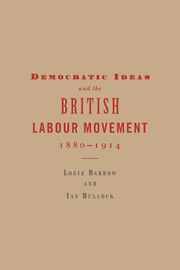Book contents
- Frontmatter
- Contents
- Acknowledgements
- Introduction
- Part 1
- Part 2
- Part 3
- 7 The early 1900s: a hinge period
- 8 Socialists and the state
- 9 Parliamentary socialism? Labour in parliament
- 10 Parliamentary democracy? ‘Fred's obsession’ and the path to the Bradford resolution
- 11 Background to syndicalism: the legacy of the NIGFLTU's failure
- 12 Avoiding the ‘Servile State’. The impact of Syndicalism and Guild Socialism
- 13 1914: an emerging consensus on the eve of Armageddon
- Conclusions
- Appendix: Federation for local Labour historians – and for national
- Index
11 - Background to syndicalism: the legacy of the NIGFLTU's failure
Published online by Cambridge University Press: 09 November 2009
- Frontmatter
- Contents
- Acknowledgements
- Introduction
- Part 1
- Part 2
- Part 3
- 7 The early 1900s: a hinge period
- 8 Socialists and the state
- 9 Parliamentary socialism? Labour in parliament
- 10 Parliamentary democracy? ‘Fred's obsession’ and the path to the Bradford resolution
- 11 Background to syndicalism: the legacy of the NIGFLTU's failure
- 12 Avoiding the ‘Servile State’. The impact of Syndicalism and Guild Socialism
- 13 1914: an emerging consensus on the eve of Armageddon
- Conclusions
- Appendix: Federation for local Labour historians – and for national
- Index
Summary
It is not difficult to understand the appeal of syndicalist ideas (i.e. of revolution via a general strike, led by a federation of single-industry unions) for those whose starting point was the ‘real democracy’ of the more radical sections of the socialist movement. Both the syndicalist method of ‘direct action’ and the syndicalist goal of industrial selfmanagement seemed to offer direct ways for workers to exercise power without politicians, officials and other intermediaries. Both method and goal had similarities to those of the referendum and initiative, or of Social-Democrat arguments for keeping the control of Schools and Poor Law Administration as direct as possible. At the same time, syndicalist ideas had a further class appeal: to the militant, or potentially militant, industrial worker rather than to the seemingly more abstract and non class-specific citizen.
Nor is there much difficulty in understanding the appeal of syndicalist ideas among union activists, irrespective of their exact political allegiances. We have underlined one central reason for syndicalism's resonance: disillusion among many activists with the Labour Party. Historians have suggested further reasons, not least anger and renewed confidence at the end of a deep though relatively brief economic downturn, growing frustration among the organised at the trammels of procedure and officialdom, and among many of the unorganised at their own powerlessness. All these further reasons are plausible, but the problem is that few of them had been absent during, say, the early 1870s, the late 1880s or late 1890s.
- Type
- Chapter
- Information
- Democratic Ideas and the British Labour Movement, 1880–1914 , pp. 218 - 245Publisher: Cambridge University PressPrint publication year: 1996

